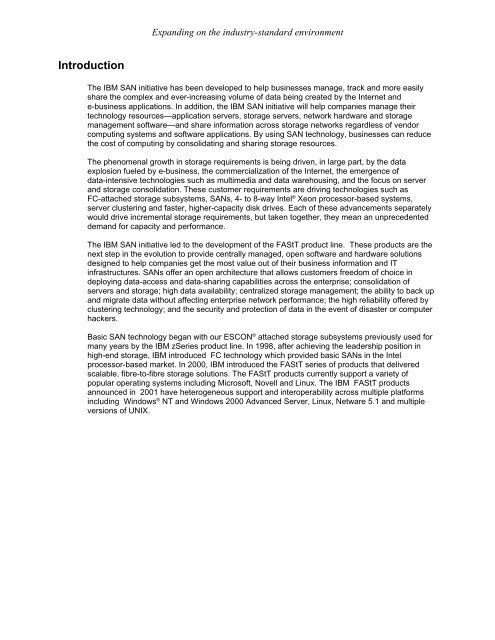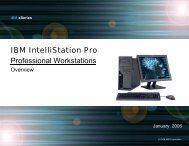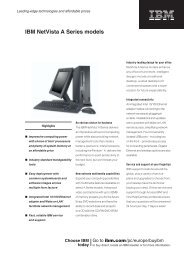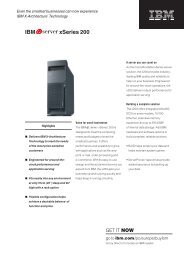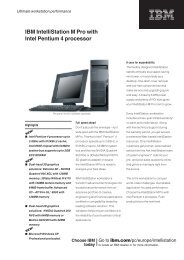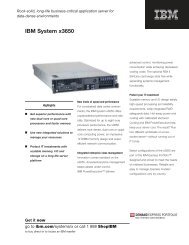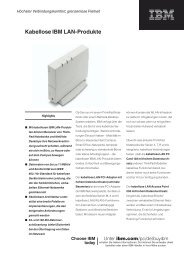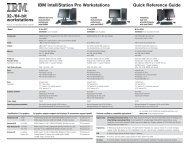IBM Storage Area Network and Fibre Array Storage Technology
IBM Storage Area Network and Fibre Array Storage Technology
IBM Storage Area Network and Fibre Array Storage Technology
You also want an ePaper? Increase the reach of your titles
YUMPU automatically turns print PDFs into web optimized ePapers that Google loves.
Introduction<br />
Exp<strong>and</strong>ing on the industry-st<strong>and</strong>ard environment<br />
The <strong>IBM</strong> SAN initiative has been developed to help businesses manage, track <strong>and</strong> more easily<br />
share the complex <strong>and</strong> ever-increasing volume of data being created by the Internet <strong>and</strong><br />
e-business applications. In addition, the <strong>IBM</strong> SAN initiative will help companies manage their<br />
technology resources—application servers, storage servers, network hardware <strong>and</strong> storage<br />
management software—<strong>and</strong> share information across storage networks regardless of vendor<br />
computing systems <strong>and</strong> software applications. By using SAN technology, businesses can reduce<br />
the cost of computing by consolidating <strong>and</strong> sharing storage resources.<br />
The phenomenal growth in storage requirements is being driven, in large part, by the data<br />
explosion fueled by e-business, the commercialization of the Internet, the emergence of<br />
data-intensive technologies such as multimedia <strong>and</strong> data warehousing, <strong>and</strong> the focus on server<br />
<strong>and</strong> storage consolidation. These customer requirements are driving technologies such as<br />
FC-attached storage subsystems, SANs, 4- to 8-way Intel ® Xeon processor-based systems,<br />
server clustering <strong>and</strong> faster, higher-capacity disk drives. Each of these advancements separately<br />
would drive incremental storage requirements, but taken together, they mean an unprecedented<br />
dem<strong>and</strong> for capacity <strong>and</strong> performance.<br />
The <strong>IBM</strong> SAN initiative led to the development of the FAStT product line. These products are the<br />
next step in the evolution to provide centrally managed, open software <strong>and</strong> hardware solutions<br />
designed to help companies get the most value out of their business information <strong>and</strong> IT<br />
infrastructures. SANs offer an open architecture that allows customers freedom of choice in<br />
deploying data-access <strong>and</strong> data-sharing capabilities across the enterprise; consolidation of<br />
servers <strong>and</strong> storage; high data availability; centralized storage management; the ability to back up<br />
<strong>and</strong> migrate data without affecting enterprise network performance; the high reliability offered by<br />
clustering technology; <strong>and</strong> the security <strong>and</strong> protection of data in the event of disaster or computer<br />
hackers.<br />
Basic SAN technology began with our ESCON ® attached storage subsystems previously used for<br />
many years by the <strong>IBM</strong> zSeries product line. In 1998, after achieving the leadership position in<br />
high-end storage, <strong>IBM</strong> introduced FC technology which provided basic SANs in the Intel<br />
processor-based market. In 2000, <strong>IBM</strong> introduced the FAStT series of products that delivered<br />
scalable, fibre-to-fibre storage solutions. The FAStT products currently support a variety of<br />
popular operating systems including Microsoft, Novell <strong>and</strong> Linux. The <strong>IBM</strong> FAStT products<br />
announced in 2001 have heterogeneous support <strong>and</strong> interoperability across multiple platforms<br />
including Windows ® NT <strong>and</strong> Windows 2000 Advanced Server, Linux, Netware 5.1 <strong>and</strong> multiple<br />
versions of UNIX.


